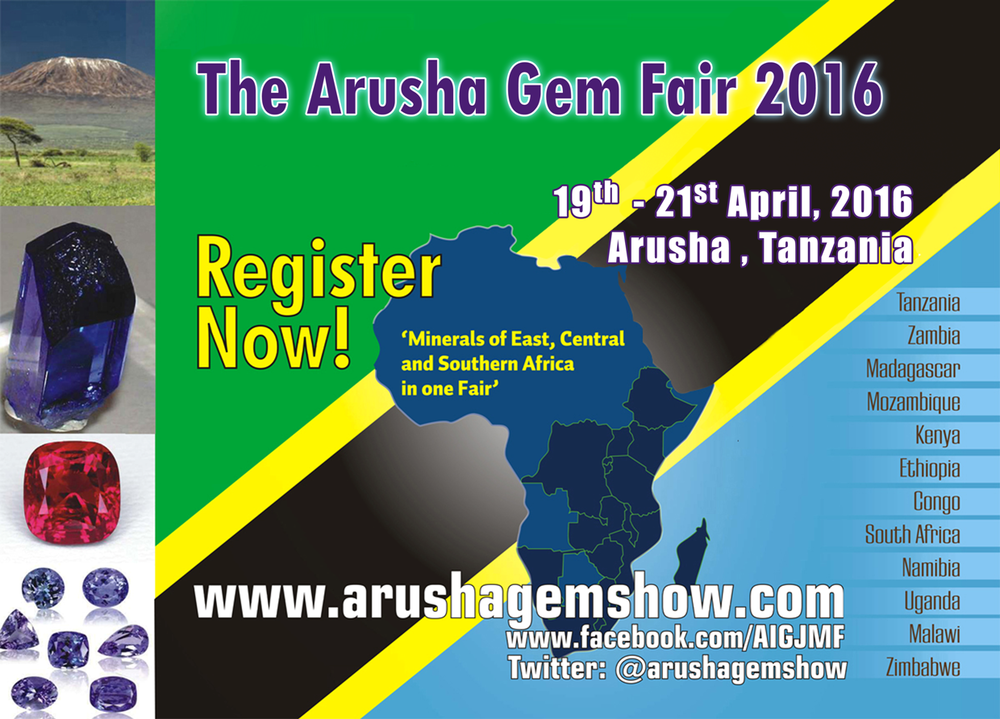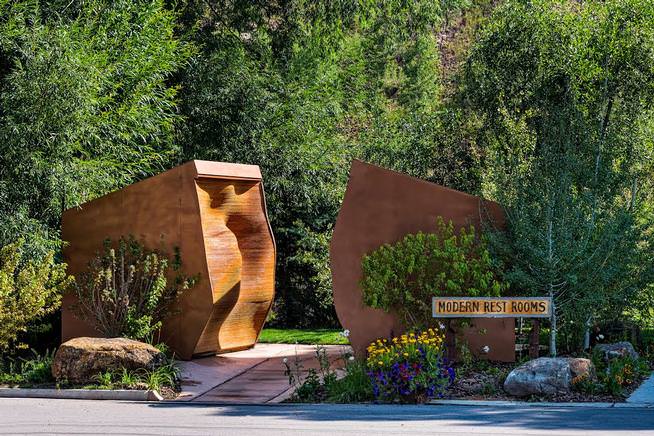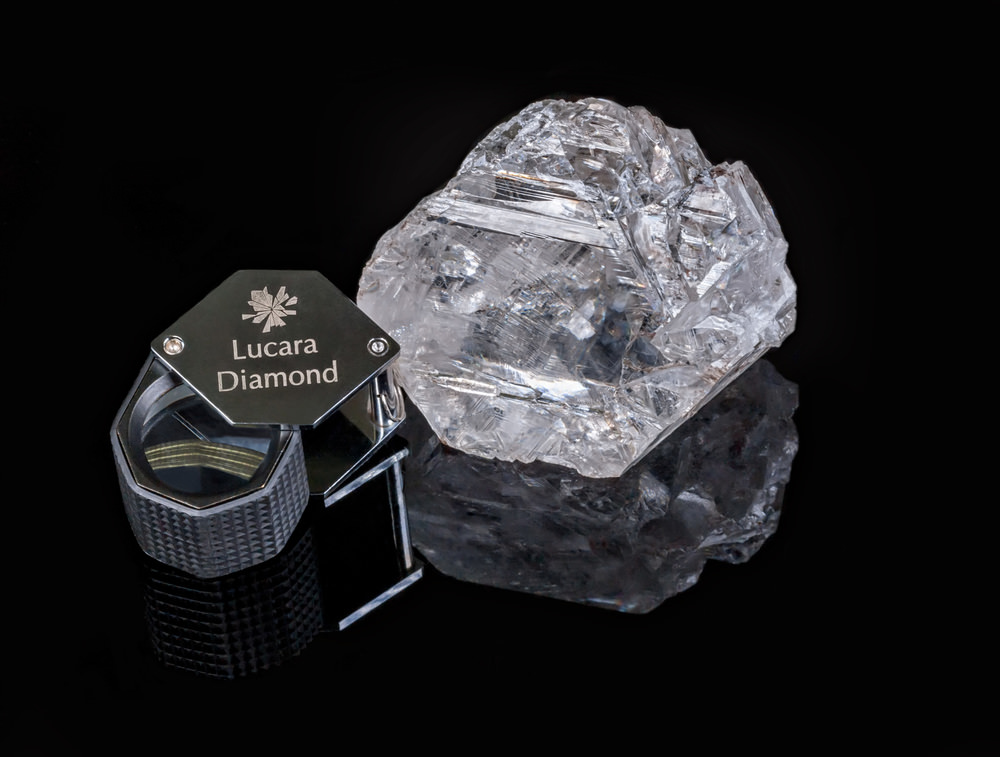December 2015
Many merry men munching in München. Clockwise from bottom: Will Larson, Bill Larson, Laurent Thomas (Polychrome Minerals), Nick Stolowitz (Green Mountain Minerals), dealer Brice Gobin (wearing DEVO energy dome hat), dealer Marcus Walter, dealer Marcus Budil, Joel A. Bartsch (CEO and Curator of Gems and Minerals, Houston Museum of Natural Science), Dylan Stolowitz (the evil twin from Green Mountain Minerals). (Photo: Restaurant server)
Table of Contents
Shows and Events
- Tucson Time: February 2–14, 2016
- Lyn Knight Auctions – The Pegmatite Collection +Plus: December 15, 2015
- Arusha Gem Fair: April 19–21, 2016
Pala International News
Minerals and Mineralogy News
Industry News
Shows and Events
Tucson Time: February 2–14, 2016
After the holidays, we're looking forward to the world's greatest gem and mineral show in February. One-stop general information about individual shows can be obtained from the Tucson EZ-Guide.
Pala International will be represented in Tucson as follows. We look forward to seeing our many friends there. Visit the Pala International Show Schedule for future events.
AGTA GemFair
Pala joins nearly 100 exhibitors for this trade-only annual extravaganza.
Event: AGTA GemFair
When: February 2–7, 2016
Where: Tucson Convention Center
Pala International Booth: 1016
The event website now features an interactive floorplan allowing you to see who is exhibiting by area of the convention center.
Free seminars by notables in the world of gemstones and pearls are listed.
15th Annual Westward Look Mineral Show
Pala International and three dozen other world-class mineral dealers shack up at the Sonoran Desert resort.
Event: 15th Annual Westward Look Mineral Show
When: February 5–8, 2016
Where: Westward Look Resort
Pala International Suite: 224, Building 20, Upper Level
See Pala International's page on the Westward Look Show site. See also this dealer map.
The poster for this year's show (at right) features a 49-mm-tall heliodor crystal from a private collection, photographed by Joe Budd. It comes from the Yellow Water Mine in Tajikistan. The crystal has a spiral inclusion that reminds us of the "Mascara Stone" that John S. White introduced us to last year, and which we included (ahem…) in our sibling e-newsletter Palagems Reflective Index.
62nd Annual Tucson Gem & Mineral Show
TGMS is the largest gem and mineral show in the country. This year's theme is "Shades of Blue: Minerals of the World."
Event: 62nd Annual Tucson Gem and Mineral Show
When: February 11–14, 2016
Where: Tucson Convention Center
Pala International Booth: 926–929
Lyn Knight Auctions – The Pegmatite Collection +Plus: December 15, 2015
Lyn Knight Auctions, of Overland Park, Kansas, a suburb of Kansas City, offers its inaugural Fine Minerals auction on December 15: The Pegmatite Collection +Plus. Lots are available for viewing by appointment beginning today. A variety of specimens are included in the sale, with fifteen beryls, thirteen fluorites, 186 tourmalines, one copper, three topaz, and a smattering of other varieties in ones and twos.
Some of our favorites:
- A deep blue aquamarine with a colorless topaz sidecar, from Minas Gerais, Brazile (Lot 2)
- A similar aquamarine, powder blue, and quartz with lovely crystal facets, from Sichuan, China (Lot 3)
- A dreamy aquamarine crystal from Shigar, Pakistan (Lot 7)
- An equally dreamy morganite and aquamarine resembling a fluorite with phantom, from Skardu, Pakistan (Lot 14)
- A beautifully striated tourmaline penknife, blue-green handle with tricolor blade, from Minas Gerais (Lot 17)
- A bluish tourmaline hugging a much larger yellow sapphire, from Sri Lanka (Lot 188)
- An ice-cream cone-shaped apophyllite on chalcedony, from Maharashtra, India (Lot 202)
- Limpid celestine crystals arising from a frosty base, from Mahajanga, Madagascar (Lot 208)
- Deep blue-green dioptase, from chunky and gemmy to delicately druzy, on calcite, from Tsumeb, Namibia (Lot 210)
Arusha Gem Fair: April 19–21, 2016
Next year's Arusha Gem Fair will be held April 19–21 in Arusha, Tanzania. Last year more than 300 buyers from 25 countries attended, with over 700 participants in all.
The show will consist of a exhibition of rough and cut stones, lapidary equipment and demonstrations, seminars and panels, keynote speakers, and mine tours.
Pala International News
Pala's Featured Specimens
With this edition of our newsletter we offer two exceptional specimens.
Goethite from Andalusia
First we feature another iridescent rainbow goethite found about 27 years ago. The perfection and coloring of this specimens is fantastic. Formerly in the collection of Emilio Rodenas.
Goethite from Alosno-Tharsis Road, Huelva, Andalusia, Spain, 8.5 x 9.5 x 5 cm. Price available upon request. (Photo: Mia Dixon)
Rutile from Madagascar
Our second featured specimen is a beautifully complex rutile from central Madagascar.
Rutile, Tetikanana, Ambatofinandrahana, Madagascar, 7.1 x 4.5 x 1.5 cm. Price available upon request. (Photo: Mia Dixon)
Interested? Contact us.
Ex-Pala MinRec Cover Star
The Inca King, a gorgeous phosphophyllite from Bolivia, recently graced the cover of the September–October edition of Mineralogical Record.
Veteran readers of Pala Mineralis will recall Pala International's Will Larson recounting his journey to Bolivia two years ago in pursuit of the specimen. Here's how the story began:
At the Munich Mineral Show in 2013 we met with one of my father's good Bolivian contacts. He told us of a very fine specimen that would probably be available on the market. It was said to be a very good phosphophyllite, still in Bolivia. Of course we were very excited, this being the "Holy Grail" of mineral specimens. The description sounded intriguing, but without photographs you never know the exact quality. Two weeks later, when we finally received images of the specimen and recognized its caliber we knew we had to jump on the chance to get it.
The specimen now is held in the collection of MIM, the Museum of Minerals in Beirut.
Pala Debuts New Website
Pala International is pleased to unveil a new website layout that will adapt its display to your various devices (smartphone, tablet, and laptop or desktop) and orientations (landscape, portrait). Virtually all of the content of the prior website is available to users, but the menus have been streamlined to avoid clutter.
Top Menu
- Shop
- Galleries
- Featured Specimens + Past Specimens
- Mineral Gallery : The complete catalog
- Bargain Bin : Specimens under $500
- High-End : Specimens over $2500
- The Hot Spot : Specimens from our world-wide contacts, direct from the source
- The Vault : Specimens that are special to us
- The Classics : Specimens from the most classic localities in the world
- Private Gallery : Compare specimens online with a Palaminerals sales person
- Library
- Articles
- Links
- Newsletters
- News
- Blog
- Search (magnifying glass icon)
- Cart (shopping cart icon)
Bottom Menu
- About Us
- Our Staff
- Policies
- Shows
- Sitemap
In the interest of launching this user-friendly website immediately, older articles and newsletters contain links that still point to the legacy site. Over the coming weeks and months we'll be updating that material and redirecting old web addresses to the new pages.
If you find what you think is a mistake, or a link points to "Oops!", send us the address of the page that contains your concern. We hope you'll enjoy using the new site.
Mineral and Mineralogy News
Rare Flea Holds Plague Key?
A rare amber from the Dominican Republic has scientists reevaluating how long one of the world's deadliest scourges has literally been plaguing the human race. As explained in an Oregon State University College of Science article posted September 28, a remarkable flea became trapped in sap about twenty million years ago. The specimen excited entomologists because fossil fleas are rare, and this one was identified as coming from a new genus, having two characteristics not seen before. The flea intrigued other scientists because it contains what looks to be an ancestor of the bacteria that caused the Black Death in 14th-century Europe, killing more than half the continent's inhabitants.
While the bacteria can't be confirmed positively, their physical characteristics mirror those of Yersinia pestis, which ravaged Europe. The coccobacillus bacteria—cocci (spherical) and bacilli (rod-shaped)—in this amber are found attached to the flea's proboscis as well as compacted in its rectum. This is significant because contemporary fleas, upon feeding on an infected animal, become, well, sort of constipated by what becomes a viscous mass in the flea's passage between esophagus and stomach. Unable to ingest enough blood, they try for more, and in the process of feeding on an new animal the bacteria-laden mass can be forced back out through the flea's proboscis. The flea-plague-vertebrate cycle was thought to have evolved 20,000 years ago; this specimen, about twenty million years old suggests that rodent parasites could have evolved long before. The findings are published by George Poinar Jr., an entomology researcher at OSU, in the Journal of Medical Entomology ([2015] Vol. 52, No. 6: 1234–1240).
Coccobacilli. The bacteria are visible on the flea's proboscis (sucking mouthpart). (Photos: George Poinar Jr., courtesy Oregon State University College of Science)
Biggest Crystal Structure Model Built in Vienna
Can something be quantified? If so, it's likely tracked by Guinness World Records: Most knots undone by a dog in three minutes (fourteen), largest fruit salad (8,690 kg), tallest road sign (18.5 m)—all of those taking place in Vienna, Austria. Now there's a new hopeful for the record book in Vienna. Dr. Robert Krickl, described by BBC as a crystallographer turned science communicator, built what he hopes will be designated the world's largest crystal structure model. It is on display in Vienna's city hall (a closing date of November 30 was extended), with the Guinness World Records adjudicating the feat on November 23.
The model forms a cube 3.1 meters on each edge, consisting of 42,875 ball of red and white held together with about 12 kilometers of connecting sticks. One hundred years ago, William Henry Bragg and William Lawrence Bragg received the Nobel Prize in Physics for discovering the type of structure used in the city hall display. It is the "ball and stick model" illustrating a cube of salt 0.0000096 mm on each edge. The model also celebrates 2014's International Year of Crystallography and 2015's International Year of Soils. For more on the project, see Dr. Krickl's project page and its Facebook page.
Rock Shows!
Here are two video clips and an image featuring fun with minerals.
Scene from Breaking Bad
DEA agent Hank Schrader says a few choice words to his wife Marie while she's unpacking a few rocks…
Scene from Big Bang Theory
Bert invites Amy Farrah Fowler out to a rock and mineral show - but ends up going with Howard Wolowitz and Raj Koothrappali. He doesn't look disappointed! ROCK SHOOOW!!!
Outhouse as Adit
Okay, so if there are world records for stupid pet tricks and room-sized table salt crystal models, there's bound to be a competition for the nation's finest restroom, right? Turns out there is, and this year the tiny mining town of Minturn, Colorado enters the Best Restroom Hall of Fame by receiving top honors from Cintas Corporation, provider of (among other things) those iconic scented urinal guards found in men's restrooms. Not so iconic is the design of the Minturn restroom in Eagle Park: it's so different-looking that you might not take it for a restroom. The fabricated wood on the two restrooms' exterior takes its inspiration from a mine entrance, or adit. Inside the Men's, the undulating wood of the exterior provides a contrast to the planar bas reliefs crafted in copper on the opposite wall. Playful butterflies swarm the corner and ceiling. While artful, the spaces are designed to be custodian-friendly and vandal-resistant. Design, construction and plumbing came in at only $90,000, according to the Denver Post.
Industry News
World's Second Biggest Diamond
On November 18, Lucara Diamond Corp. announced the "recovery" of a 1,111-carat gem quality, Type IIa diamond. The stone was unearthed in the south lobe of the firm's Karowe Mine in central Botswana. At 65 x 56 x 40 mm in size, it is the largest ever produced by the country. William Lamb, President and CEO, stated in a news release, "Our focus on mining the south lobe, which is delivering value beyond expectation, has been perfectly timed with the commissioning of our recent plant modifications, enabling the recovery of these large, high quality exceptional diamonds." A Mindat profile of the Karowe Mine states that the mine's diamond-bearing kimberlite pipe, discovered by De Beers in 1969, originally was believed to be small and of inferior grade. But in 2003, it was revealed to be larger and finer. A Lucara subsidiary leased the mine in 2008, then bought it the next year.
The next day, Lucara announced the recovery of two more "exceptional" colorless diamonds, one 813 carats and the other 374 carats, uncleaned. The larger stone is the sixth largest gem quality diamond ever mined, according to Lamb. Both stones came from the south lobe of the Karowe Mine.
MineralDesk Curator
A South African software company is working with Mindat.org's Jolyon Ralph to develop a desktop application for the mineral enthusiast. MineralDesk Curator is an inventory system on steroids. Not only does it track the items of your collection, it allows you to customize several labels based on various needs. If your data changes, Curator tells you to reprint a label. It will tell you if you're missing data based on a threshold you set. Data can be imported and exported via standard CSV files. Images can be imported and edited, without affecting your originals. There is movie and document management, too. You can buy and sell in different currencies and use a free cloud account to publish on a variety of sites like Facebook and eBay.
The easiest way to take in most of Curator's features is to watch this brief streaming video.
Curator currently offers a public beta program for Mac and Windows. Users will be able to get 25% off Curator when it launches. According to the MineralDesk website, Curator is fully integrated with Mindat, so the program will work with the website to validate your species, obtain your species chemical formulae, match localities, obtain a unique minID for your mineral, import mineral data from your Mindat.org catalog, and share your photos with the website.
MineralDesk has ambitions beyond the mineral field. "MineralDesk is part of a much larger project called TradeMesh," its website explains, "which at its core, will use MineralDesk technology in order to catalog a wider variety of real world objects so that they can be shared, compared, bought and sold on a discreet basis."
To Fund or Not to Fund
Mine spills in Colorado have made national headlines over the past few months. Conspiracy theorists might suspect that the Environmental Protection Agency intentionally flubbed in releasing mine waste in order to bring attention to the dirty little secret hidden away in the hills. The Denver Post wrote on October 25 that the Western states contain tens of thousands of inactive mines that taint the headwaters of the country's rivers. State officials have documented about 230 sites in Colorado that are slowly becoming degraded.
If this is such a challenge, and if there's money to fix it, in the form of federal Superfund dollars, isn't accepting the cash a no-brainer? Not to the residents of Silverton, the county seat and only incorporated city in San Juan County, in southwestern Colorado. Silverton's name notwithstanding, it was gold that was found in the San Juan Mountains a few miles to the northeast, appropriately in Eureka, in 1860. In 1873, silver was discovered in August, and a treaty was signed in September with the Ute Native Americans in which they turned over four million acres of land for an annual fee of $25,000. The Sunnyside Mine was named after the silver vein that ran along Hurricane Peak, located about halfway on State Highway 110 that runs from Silverton to Eureka. Gold was discovered in 1882, and the railroad reached the town. The Grand Hotel opened the next year. The town of three thousand would in the early 1900s gain a Carnegie Library, a county courthouse and jail, a town hall, a miners union hall, and other prominent buildings.
Mining Town. Silverton lying below Sultan Mountain, 1901. (Photo: Detroit Photographic Co.)
The Sunnyside Mine shut down after the 1929 stock market crash. It was purchased in 1959 and opened again, and the Little Mary vein produced gold. In 1978, disaster struck a tunnel of the Sunnyside (as described by the Denver Post on August 8 this year). The Sunnyside tunnel had extended to below Lake Emma, an alpine lake just south of Hurricane Peak. Trouble was, only seventy feet separated the shaft from the lakebed. Fortunately it was a Sunday when the inevitable took place. The lake's water and sediment rushed through the tunnel, escaping via a Cement Creek portal, toppling a twenty-ton train engine. Cement Creek was the site of the most recent spill from the nearby Gold King Mine.
For the last twenty years Silverton has declined those Superfund dollars to clean up the myriad mines. Yet the town has pursued a congressional appropriation that failed. The reason for reticence is simple, as explained by the Denver Post November 17: Superfund designation would stigmatize the town as well as mire the municipality in rules and regs. Six days later the town's and county's officials gave in, voting unanimously on November 23 to begin the necessary negotiations to get the Superfund ball rolling, as reported by the Post.
— End December Newsletter • Published 12/1/15 —
Note: PalaMinerals.com selects much of its material in the interest of fostering a stimulating discourse on the topics of minerals, mineralogy, and the mineral industry. Therefore the opinions expressed here are not necessarily those held by the proprietors of PalaMinerals.com. We welcome your feedback.


















